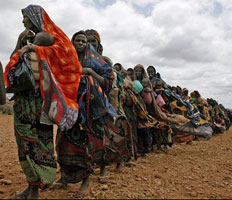Malnutrition
Malnutrition is a phenomenon related both to a shortage in food security and to medical issues.
Its occurrence is often but not always related to food shortage. The persons affected are to be perceived as being in need not only of food but of medical supervision, attendance and care.
The phenomenon of malnutrition and procedures of aid are extensively explained by the Sphere Project and by Médecins Sans Frontièrs.
 Average Nutrition Requirements:
Average Nutrition Requirements:
- 2100 kcals per person per day
- 10-12 % provided by protein
- 17 % provided by fat
- Micronutrients: Vitamin A, B1 (Thiamine), B2 (Riboflavin), B3 (Niacin), B12, C, D, E, K, Iron, Magnesium, Zinc, Selenium, Folic Acid, Iodine, Biotin, Pantothenate
Demography:
These figures are not connected to any age or gender, but are absolutely average for a population pyramid of:
- 0 – 4 years: 12%
- 5 – 19 years: 33%
- 20 – 59 years: 49%
- 60+ years: 7%
- pregnant + breast-feeding: 5%
- male/ female: 51%/ 49%
Requirements have to be adapted to the demographic structure, especially regarding the percentage of those under five year of age, females and HIV infected.
Activity Levels:
Activity levels and the average ambient temperature should be considered: if it is less than 20°C nutrition requirements increase.
 Assessment:
Assessment:
Children under five are most affected:
- Initial assessment by the MUAC (Middle Upper Arm Circumference).
- Colors on the stripe indicate if the child is malnourished.
- More defined by the W/H (Weight-for-Height-Index)
Other vulnerable groups: pregnant and breast-feeding women, elderly and HIV/AIDS infected.
Deficiencies:
- Marasmus: lack of calories: extremely thin, skin folds, lethargy, poor appetite, irritability
- Kwashiorkor (Protein): swollen belly (fluids in the stomach), arms, legs, feet, hands and face, lethargy
- Diseases by a shortage of a certain nutrient: Xerophtalmia (Vitamin A), Scurvy (Vitamin C), Pellagra (Niacin), Goitre (Iodine), Beri-Beri (Thiamine), Riboflavin
- Malnourished are easily infected by other diseases: diarrhea, measles, malaria, etc. and dehydration.
- Malnutrition may lead to delays and deficiencies in overall development.
 Nourishment Programmes
Nourishment Programmes
It is impossible to examine the whole population:
- The nutritious status of those under five year of age can be used as a an indication for the overall situation, as they are the most vulnerable.
- Records of health centres
- Major disease outbreaks
- Mortality figures
- Analyzing markets, agriculture, distributions, wild foods
Programme is chosen by both malnutrition rates and aggravating factors such as diseases and climate.
Severe Malnutrition:
- Therapeutic feeding centre
- 24-hour in-patient care, day care, and home-based care
Moderate Malnutrition:
- Supplementary Feeding centres: rations to take home
- Targeted supplementary feeding
- Blanket supplementary feeding:
- If moderate malnutrition rates are so high that cases can’t be responded to individually
 Moderate Malnutrition:
Moderate Malnutrition:
- Supplementary feeding is based on the distribution of dry take-home rations unless there is a clear rationale for on-site feeding
- More than 90% of the target population is within one day’s return walk (including time for treatment) of the distribution centre for dry ration supplementary feeding
- No more than one hour’s walk for on-site supplementary feeding programmes
- The proportion of exits from targeted supplementary feeding programmes who have died is <3%, recovered is >75% and defaulted is <15%
- Admission of individuals is based on assessment against internationally accepted anthropometric criteria
- Targeted supplementary feeding programmes are linked to any existing health structure and protocols are followed to identify health problems and refer accordingly
 Severe Malnutrition
Severe Malnutrition
- Treated in therapeutic feeding centre/ 24-hour-care
- The proportion of exits from therapeutic care who have died is <10%, recovered is >75% and defaulted is <15% Discharge criteria include non-anthropometric indicators such as good appetite and the absence of diarrhea, fever, parasitic infestation and other untreated illness. Mean weight gain is >8g per kg per person per day
- Nutritional and medical care is provided according to internationally recognized therapeutic care protocols
- As much attention is attached to breastfeeding and psychosocial support, hygiene and community outreach as to clinical care
- There should be a minimum of one feeding assistant for 10 inpatients.
 Treatment
Treatment
First phase: 24-Hour Care
- Naso-gastric-feeding only in emergency: child to weak to drink, repeated vomiting etc.
- Diet providing just enough energy and protein for maintenance to allow readjustment of metabolic mechanisms and re-hydration: 100kcal/kg/day and 3g/protein/kg/day
- High number of small feeds; (8-10/ day)
- High Energy Milk (Dried skim milk, vegetable oil and sugar)
- Not more than one week, no weight gain
 Second phase: Day-Care
Second phase: Day-Care
- When most severe medical complications (dehydration, hypothermia etc) are under control, and appetite is recovered
- Higher rations for weight gain,
- Nutritional rehabilitation
- Wet rations: prepared once or twice daily in a feeding centre and consumed on site. Appropriate when firewood or cooking utensils are missing or security problems
- Dry rations: distributed (usually weekly ) to take home: easier to organize, more efficient, can help to prevent displacement
Dry rations might disappear into the family pot, or can be seen as a substitute for the family meal. Therefore dry rations are always mixed already and are a complete energy ration for a day.
Composition of rations: base (cereal: rice, corn) high-protein source (beans, lentils, soya), high energy-source (oil, sugar) and micronutrients. If possible locally available, if not, ready-made blend of corn-soya.



